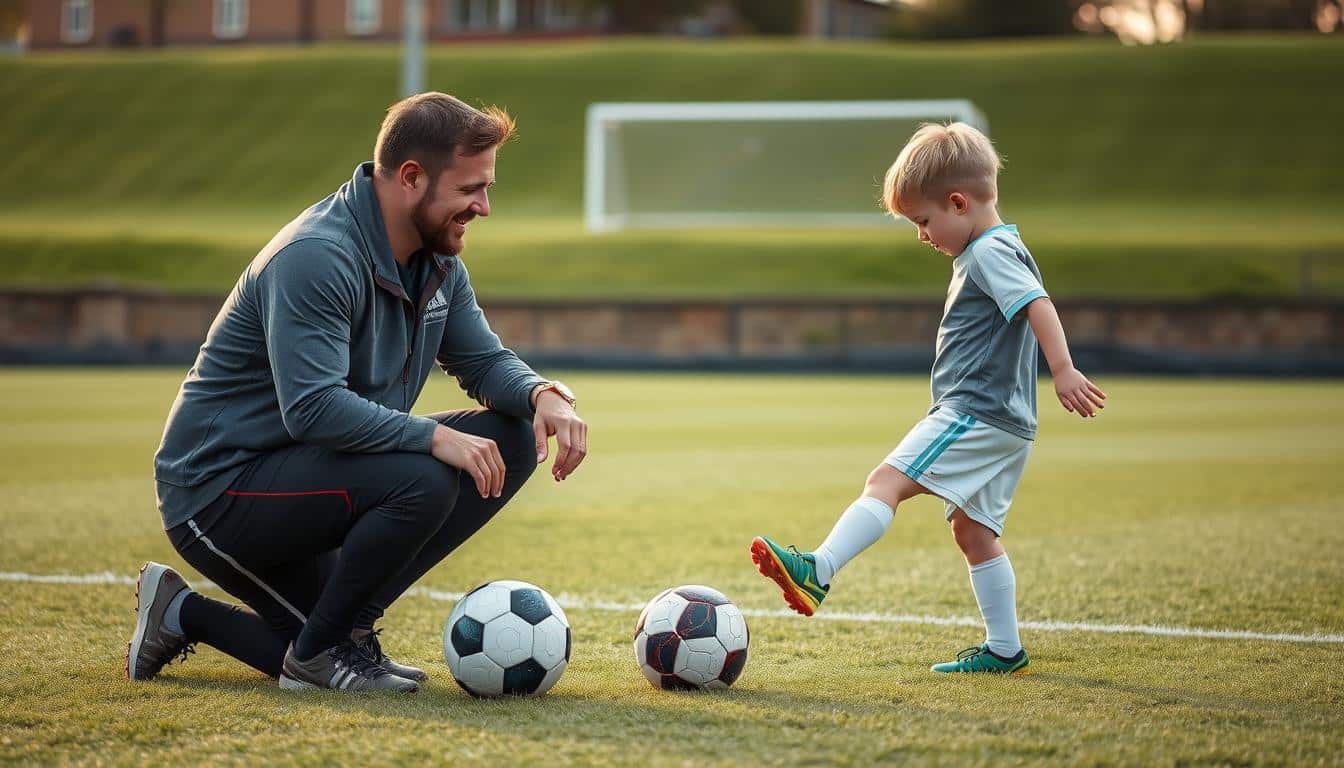How to Master Soccer Coaching Basics for Parents

Ever found yourself on the sidelines, wondering how to turn your child’s team into a cohesive, confident group? Coaching youth sports can feel overwhelming—especially if you’re new to the game. But what if you could skip the trial-and-error phase and start with proven strategies from experienced mentors?
This guide cuts through the confusion. You’ll learn how to structure practices that keep kids engaged, manage sideline dynamics, and build skills step-by-step. We’ve packed it with insights from youth soccer coaching strategies that actually work—no guesswork required. Whether you’re organizing your first drill or preparing for game day, these fundamentals will help you create a positive, productive environment.
Key Takeaways
- Learn structured practice plans that maximize player development
- Discover behavior management techniques for smoother team dynamics
- Get expert-approved drills tailored for young athletes
- Build confidence in organizing games and season schedules
- Access time-tested methods to avoid common coaching pitfalls
Getting Ready: Preparing for Youth Soccer Coaching
Before the first whistle blows, successful team organizers know preparation is key. A well-planned start builds trust and sets expectations for everyone involved. Let’s break down two critical steps to launch your season smoothly.
Hosting a Pre-Season Parents Meeting
Begin with a face-to-face gathering to align goals. Share essential details like practice times, required gear, and emergency contacts. But don’t stop there—explain your approach to skill-building and sportsmanship. This clarity helps families understand your vision for player growth.
| Must-Cover Topics | Why It Matters |
|---|---|
| Season schedule & rain dates | Prevents scheduling conflicts |
| Required shin guards & cleats | Ensures player safety |
| Volunteer sign-up sheet | Distributes responsibilities fairly |
| Positive cheering guidelines | Creates supportive sidelines |
Setting Clear Communication Channels
Choose one main method for updates—like email or a group app—and stick with it. Share weekly summaries highlighting progress and next steps. When parents know where to find information, they’re less likely to interrupt practice with questions.
Pro tip: Create a shared document for game-day snacks and carpool schedules. This small step keeps everyone informed while building team spirit. Remember, consistent updates prevent 73% of common misunderstandings according to youth sports surveys.
Soccer coaching basics for parents: Essential Drills and Practice Organization
Transform practice time into skill-building moments that young athletes look forward to. Effective sessions blend structure with creativity, helping players grow while keeping energy high.

Skill-Building Through Repetition
Start with drills that mirror real-game scenarios. Try these:
- Passing triangles: Three players practice quick ball movement
- Cone dribbling: Develop footwork with zigzag patterns
- Target shooting: Use chalk circles on fences as aiming points
Keep instructions under 15 seconds. Use visual demonstrations instead of lengthy explanations.
Blueprint for Productive Practices
A 60-minute session could follow this flow:
| Segment | Duration | Focus Area |
|---|---|---|
| Warm-up games | 10 mins | Team bonding |
| Skill stations | 25 mins | Technical development |
| Scrimmage | 20 mins | Game strategy |
Fueling Excitement on the Field
Swap traditional drills for challenges like “Shark Attack” (dribbling past defenders) or relay races. Rotate activities every 10 minutes to match short attention spans. End with a team cheer to celebrate progress.
Share practice plans with families through email or apps. When caregivers understand the method behind drills, they become better supporters during home play sessions.
Managing Sidelines and Game-Day Behavior
Game days should focus on growth, not stress. Clear guidelines help everyone support young athletes effectively while keeping the environment positive.
Spectator Code of Conduct
Set expectations early with these guidelines:
| Do | Don’t |
|---|---|
| Cheer effort over outcomes | Argue with referees |
| Use encouraging phrases | Shout instructions |
| Applaud both teams | Critique individual plays |
Explain these rules during pre-season meetings. Team managers should gently remind spectators who forget – a simple “Let’s keep it positive!” often works.
Addressing Disruptions Quickly
If behavior affects play:
- Pause the game briefly
- Calmly restate expectations
- If issues continue, substitute the child temporarily
This approach emphasizes collective responsibility. Most families appreciate consistent enforcement – it protects everyone’s experience.
Remember: 82% of youth athletes perform better when sideline energy stays supportive. Your leadership creates space for skill development and joy in the game.
Wrapping Up Your Coaching Strategy
Building a thriving youth sports experience hinges on simple, consistent habits. Start by reinforcing clear communication through regular updates and shared documents – this keeps everyone aligned from pre-season meetings to final matches.
Effective practice routines blend skill-building with fun. Rotate activities like passing challenges and mini-games to maintain energy levels. Remember: short demonstrations work better than long explanations for young players.
Sideline success requires teamwork beyond the field. Remind families to cheer effort over outcomes using your pre-established guidelines. Consistent enforcement of these behavior standards protects the positive environment athletes need to grow.
Review your season plan this week. Adjust practice drills using the structure shared earlier – warm-ups, skill stations, and scrimmages create balanced development. Small tweaks based on player feedback often yield big results.
Great team leadership starts with celebrating progress, not perfection. Keep sessions lighthearted while maintaining focus on core skills. With these tools, you’ll create a season where growth and enjoyment share center stage.
